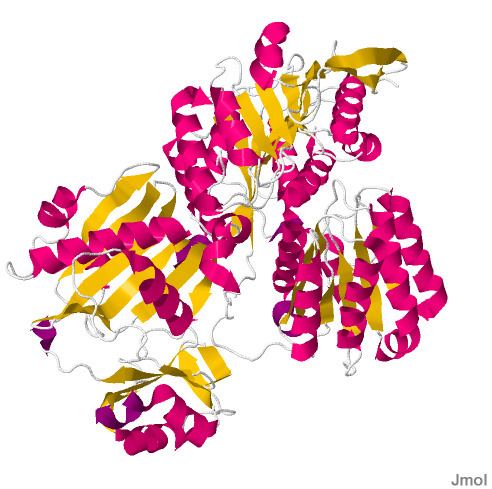Symbol ACLY HUGO 115 RefSeq NM_001096 | Entrez 47 OMIM 108728 UniProt P53396 | |
 | ||
ATP citrate lyase is an enzyme that in animals represents an important step in fatty acid biosynthesis. ATP citrate lyase is important in that, by converting citrate to acetyl CoA, it links the metabolism of carbohydrates, which yields citrate as an intermediate, and the production of fatty acids, which requires acetyl CoA. In plants, ATP citrate lyase generates cytosolic acetyl-CoA precursor of thousands of specialized metabolites including waxes, sterols, and polyketides.
Contents
Function
ATP citrate lyase is the primary enzyme responsible for the synthesis of cytosolic acetyl-CoA in many tissues. The enzyme is a tetramer of apparently identical subunits. The product, acetyl-CoA, in animals serves several important biosynthetic pathways, including lipogenesis and cholesterogenesis. It is activated by insulin. In plants, ATP citrate lyase generates the acetyl-CoA for cytosolically-synthesized metabolites. (Acetyl-CoA is not transported across subcellular membranes of plants.) These include: elongated fatty acids (used in seed oils, membrane phospholipids, the ceramide moiety of sphingolipids, cuticle, cutin, and suberin); flavonoids; malonic acid; acetylated phenolics, alkaloids, isoprenoids, anthocyanins, and sugars; and, mevalonate-derived isoprenoids (e.g., sesquiterpenes, sterols, brassinosteroids); malonyl and acyl-derivatives (d-amino acids, malonylated flavonoids, acylated, prenylated and malonated proteins). De novo fatty acid biosynthesis in plants is plastidic, thus ATP citrate lyase is not important for this pathway.
ATP-citrate lyase is responsible for catalyzing the conversion of citrate and CoA into acetyl-CoA and oxaloacetate, along with the hydrolysis of ATP.
Reaction
In the presence of ATP and Coenzyme A, citrate lyase catalyzes the cleavage of citrate to yield acetyl CoA, oxaloacetate, ADP, and orthophosphate:
citrate + ATP + CoA + H2O-->oxaloacetate + Acetyl-CoA + ADP + Pi.This enzyme was formerly listed as EC 4.1.3.8.
Location
The enzyme is cytosolic in plants and animals.
Structure
The enzyme is composed of two subunits in green plants (including Chlorophyceae, Marchantimorpha, Bryopsida, Pinaceae, monocotyledons, and eudicots), species of fungi, Glaucophytes, Chlamydomonas, and prokaryotes.
Animal ACL enzymes are homomeric, presumably an evolutionary fusion of the ACLA and ACLB genes probably occurred early in the evolutionary history of this kingdom.
A structure of human ATP citrate lyase was determined using X-ray diffraction to a resolution of 2.10 Å. The enzyme is composed of two polymer chains which are polypeptides. Chain A of the first polymer is 425 amino acids in length. Chain B of the second polymer is 334 amino acids in length.
